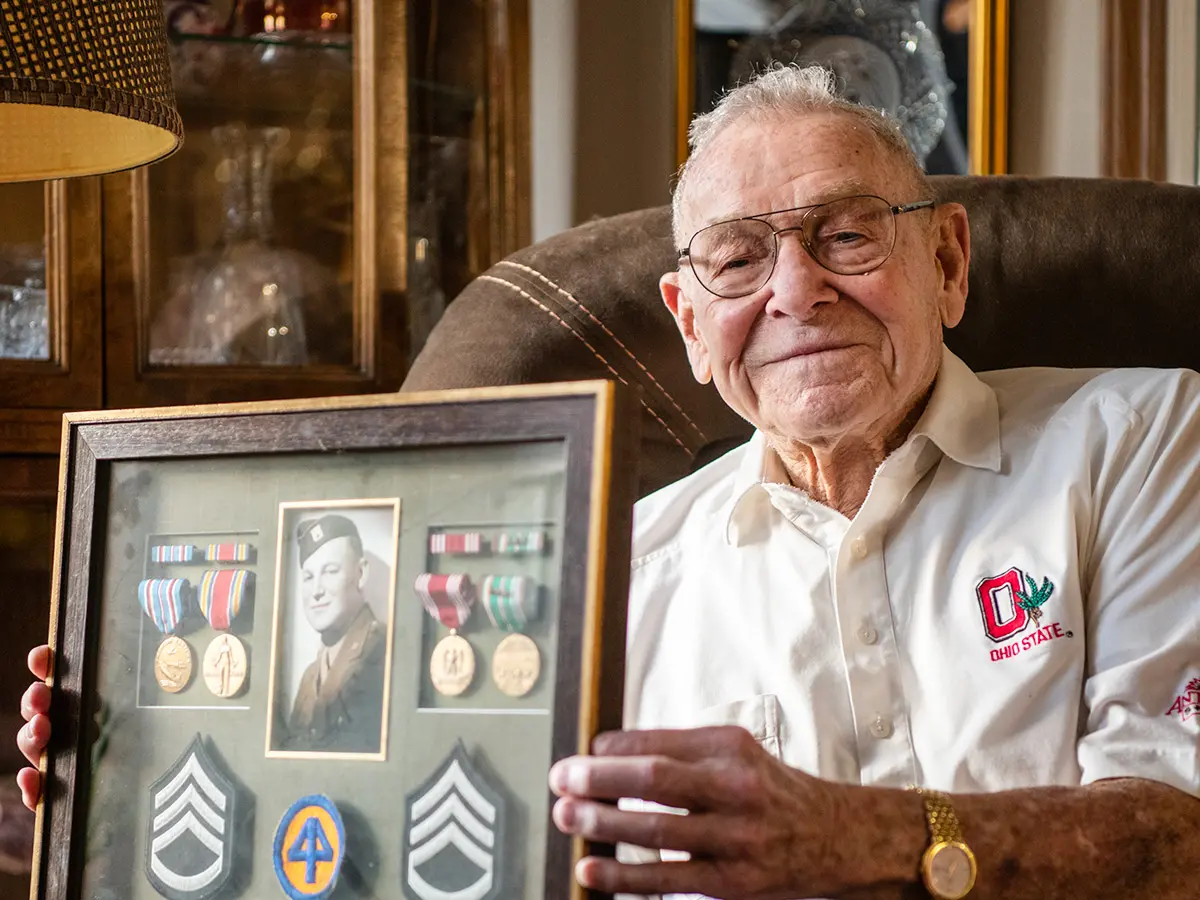
1950 alum, WWII veteran nears age 100 with gratitude
Dick Wood survived dozens of combat flights, dropped bombs with his bare hands and was saved when a professor recognized his PTSD.

The intervention of an Ohio State professor was life-changing for Staff Sgt. Richard “Dick” Wood ’50. Freshly back from serving in some of the most pivotal air battles of World War II, the then-21-year-old freshman made it two weeks into the quarter before a professor pulled him aside to ask why he kept falling asleep in class. Wood didn’t know that had been happening.
“I had an extremely heavy combat experience during the war,” Wood says. “I struggled when I returned home.”
The professor sent the young vet to Ohio State’s medical center, where he was diagnosed with combat fatigue—what we now call post-traumatic stress disorder (PTSD). This was a time when mental health issues were relegated to the shadows. “It was very, very difficult and embarrassing,” he remembers. “And it caused you to be antisocial.”
From where he sits now—a month shy of his 100th birthday, at home at Friendship Village of Dublin—it was one of the greatest moments of his quite remarkable life.
From Columbus to the Pacific

Wood’s grandfather taught him how to handle a gun as soon as he was old enough to lift one. So Wood stood out from his fellow enlistees in gunnery school. Before he even finished training, he was picked to join a flight crew in the Pacific in need of a tail gunner.
Days later, he found himself in New Guinea, folded into a cramped redoubt tucked between the rear fins of a B24 bomber. He was just months past his high school graduation and playing drums at bars on High Street, trying to emulate swing legend Buddy Rich.
In addition to manning the 50-mm guns in the tail of the plane, Wood was assigned to climb into the open bomb bay to manually release each ordnance over its target. “I had to walk this little rail, and I couldn’t wear a parachute, because [it] was too big. I had to hold on with one hand, then reach out to pull the cord to let the bombs drop,” he says. “Sometimes I’d get along well, and sometimes I’d get stiff. I’d get terrified—a lot of antiaircraft coming up at you.
“It was the worst experience of my life.”
Disaster diverted mid-Pacific
Despite numerous brushes with death—one time, enemy fire obliterated his tail gunner position just after he stepped out to give first aid to a wounded crewmate—his closest call was on his way home.
He hitched a ride on a 12-hour flight from Okinawa to Hawaii. Shortly into the 4,700-mile journey, the plane lost an engine and began to lose altitude. A few hours later, a second engine blew and the prognosis for survival looked dire. Then, just as all hope was lost, the navigator spotted a dot on the sea below—a shuttered submarine base with an airstrip and enough tools to fix the plane.
They made it to Hawaii, then San Francisco, where he caught a cross-country train to Columbus. Wood’s family welcomed him as a hero, but American society was eager to move on from the war. This gave added impetus to keep his combat stories to himself. He says his excitement about starting classes at Ohio State overshadowed any lingering issues from his service.

‘He restarted me’
Until his professor intervened, Wood never dreamed he could be suffering from a mental health issue.
After his diagnosis, he dropped out of school and went to work on his Uncle Mickey’s farm in Chillicothe, Ohio. “He was a brilliant man. He graduated from Ohio State,” says Wood, who would sleep on the home’s screened porch at night. “[Mickey would] come out to the porch and read to me. He had an amazing library.” It was Wood’s introduction to the classics and new ideas.
“I think he restarted me,” Wood says with palpable gratitude.
He returned to Ohio State the next semester with a newfound love of literature and philosophy. He graduated in 1950 with a degree in English and moved briefly to New York, then followed opportunity to Syracuse and Indianapolis, before returning to Columbus where he and his wife, Margaret, began a family.
Finding and sharing peace

After retiring from a successful business career, Wood enrolled in a two-year program to become a spiritual guidance director. “I wanted to help and teach and try to, I guess, pay back for surviving the war.”
He went to work at Maryhaven, an addiction resource clinic in Columbus, where he was assigned five female clients with histories of trauma and substance abuse. He was unsure how effective he was and remembers one of the women remarking with skepticism, “Here comes that guy who’s trying to make us well.”
A few years later, Wood was walking down Broad Street with a friend, when another woman, a former Maryhaven client, rushed up and grabbed him. His friend took off running. “He was terrified,” Wood laughs. “She picked me up and held me in the air and told me how wonderful she was feeling.”
Wood beams at the memory. “She said thank you, thank you, thank you!”
A chance meeting at a diner in Granville introduced him to the founder of Save a Warrior (SAW), an Ohio-based organization that helps veterans with meditation and other healing workshops. That began a decades-long relationship with SAW, and his portrait now hangs in the entrance to its treatment facility in southern Ohio.
Championing veterans’ education today
Through his incredible lifetime of service, Wood holds a fond place in his heart for his alma mater. “Ohio State was very special,” he says. “They tried hard to help veterans in any way they could.”
He continues to follow campus news and is excited that President Walter “Ted” Carter is putting a renewed focus on educating veterans. His advice is to talk with them, individually, to learn their needs.
“That would be the greatest gift, to have someone to talk to, that understands the fact that maybe you’re a little different, that you’re kind of off the scale for the moment, and you’re trying to get back in the culture and might need a little help.”

